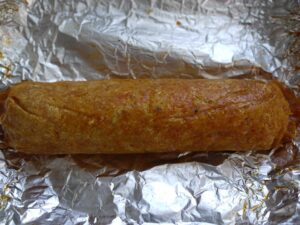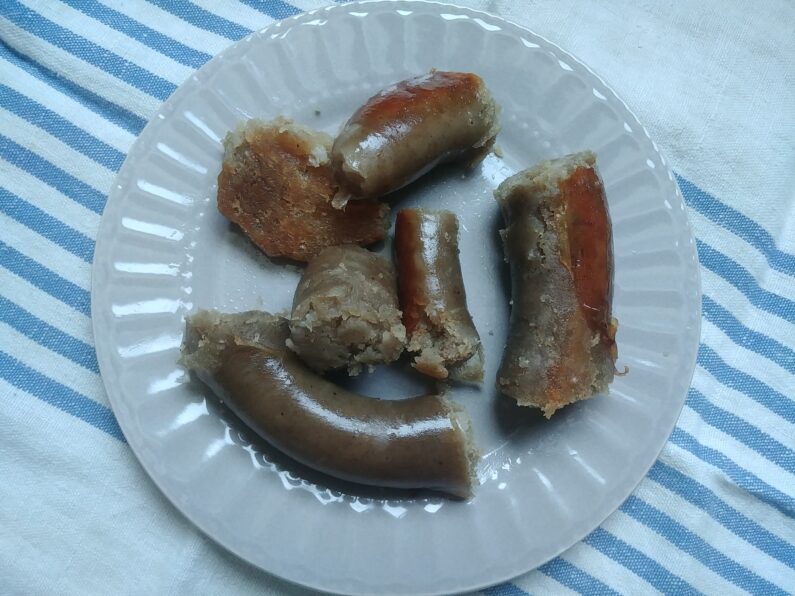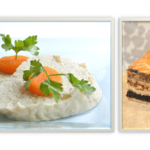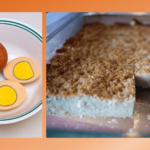Thinking about kishke (or kishkeh, kishka, etc.), so many questions spring to mind. How did it become so beloved in Ashkenazi cuisine? Who even thought it was a good idea to make in the first place? And why do so many Ashkenazi food names start with “k” (e.g. kugel, knaidlach, knish, kasha, kreplach, etc.)?
While I may not have a good answer for that last question (I research food history, not linguistics), I plan here to answer the other questions, while also giving you a number of other interesting pieces of information about kishke, the sausage-that-isn’t-exactly.
What is Kishke?
Kishke stuffs a casing typically with a mixture of flour, fat, and some flavorings (such as onion and/or paprika). The casing is what gives the dish its name; “kishke” is a Slavic word meaning guts or intestines, the original casing that was most commonly used. It also gives the dish its only-used-in-books-and-advertising English name, “stuffed derma.”
From the description, you may notice it sounds like a sausage. Sausages, traditionally, used intestines as casings for a variety of meats that were then preserved by a combination of means: salting, use of garlic (an anti-bacterial), smoking, etc. In this sense, sausages are the ultimate frugal food, both finding ways to use the otherwise inedible intestines, preserving the stuffing so it won’t spoil before you eat it, and often also using less palatable cuts of meat for the stuffing itself.
And yet, I say that kishke is not exactly a sausage, primarily due to its filling. Unlike virtually all sausages worldwide, traditional kishke is made with no meat inside. The closest one gets is the use of schmaltz, a meat-based fat. Thus, although kishke is not quite a sausage, if sausage is the ultimate thrift food, kishke is the uber-ultimate one! While it still uses the otherwise wasted intestines, the stuffing is purely there to fill a belly. When you don’t have much meat, you don’t need to devise ways to preserve it. But you still need to find ways to combat hunger with less expensive ingredients.
The term “poverty food” and the concept that Jews historically ate certain things “because that’s all they had” is, in my opinion, highly overused. Jews were not poor everywhere at all times throughout our history. And even at times and places when/where we were indeed impoverished, there were usually at least some wealthier individuals who ate similar foods as their poorer coreligionists. That being said, it seems difficult to argue against kishke as a genuine example of poverty food. I think the concept does apply here, even if it is overused as an explanation in other cases.
History of Kishke (or Kishtory?)

Despite that origin, Jewish kishke is not without its parallels in other cuisines. For starters, there are parallel foods found in non-Jewish Eastern European cuisines. Many cultures throughout Eastern Europe have similar sausages, some even called similar names (such as kiszka). Still, virtually all of these non-Jewish versions differ fundamentally from Ashkenazi kishke, and not just because they almost exclusively stuff pig intestines while the Jewish version typically uses cow. They also almost all contain some kind of meat, alongside the starchy stuffing. For some, the meat in the stuffing comes from organs such as liver. Maybe the closest parallel to kishke is the Polish kaszanka. It uses buckwheat (the aforementioned kasha) and pigs blood. In fact, kishke was popular enough in Eastern Europe to inspire a comedic polka music classic, “Who Stole the Keeshka?”
Interestingly, many non-Ashkenazi Jewish communities also made use of the animal intestines in similar fashion, and also often included them in their Shabbat stews. In particular, we encounter it in North African and Kurdish Jewish cuisines. However, related to the fact that we were not always poor wherever we lived, these bonus foods actually used meat (albeit often other offal) in their stuffings.
Finally, even within Ashkenazi versions, not all kishkes were created equal. The stuffing varies from place to place and person to person. Though a standard wheat flour is common, some used potatoes, or a combo of potatoes and flour. In parts of Romania, cornmeal (which is super popular there) often replaced the flour. And even in Eastern Europe, wealthier individuals mixed some chopped offal in with their kishke filling, rather than forsaking the dish entirely. Plus, in various areas, matzo meal may have replaced plain flour for Passover kishke.
Though almost all kishkes today are made using non-animal casings (cellulose and the like), and few people make the dish at home anymore, it remains among the very popular Ashkenazic comfort foods. People still often cook them inside their chulents, but also might cook and eat them separately as an independent side dish. However you make or eat them, they are sure to stick to your kishkes, filling you for a long time as they were always designed to do!
Know Someone Who’d Love This? Pass it Along!







Kishke: Unraveling the Gut-Deep Culinary Traditions of Ashkenazi Jews - Aish.com
[…] impoverished throughout history. Jewish culinary historian, Joel Haber, points out on his blog Taste of Jew that North African and Kurdish Jews would include meat in their kishke (usually offal). Some […]